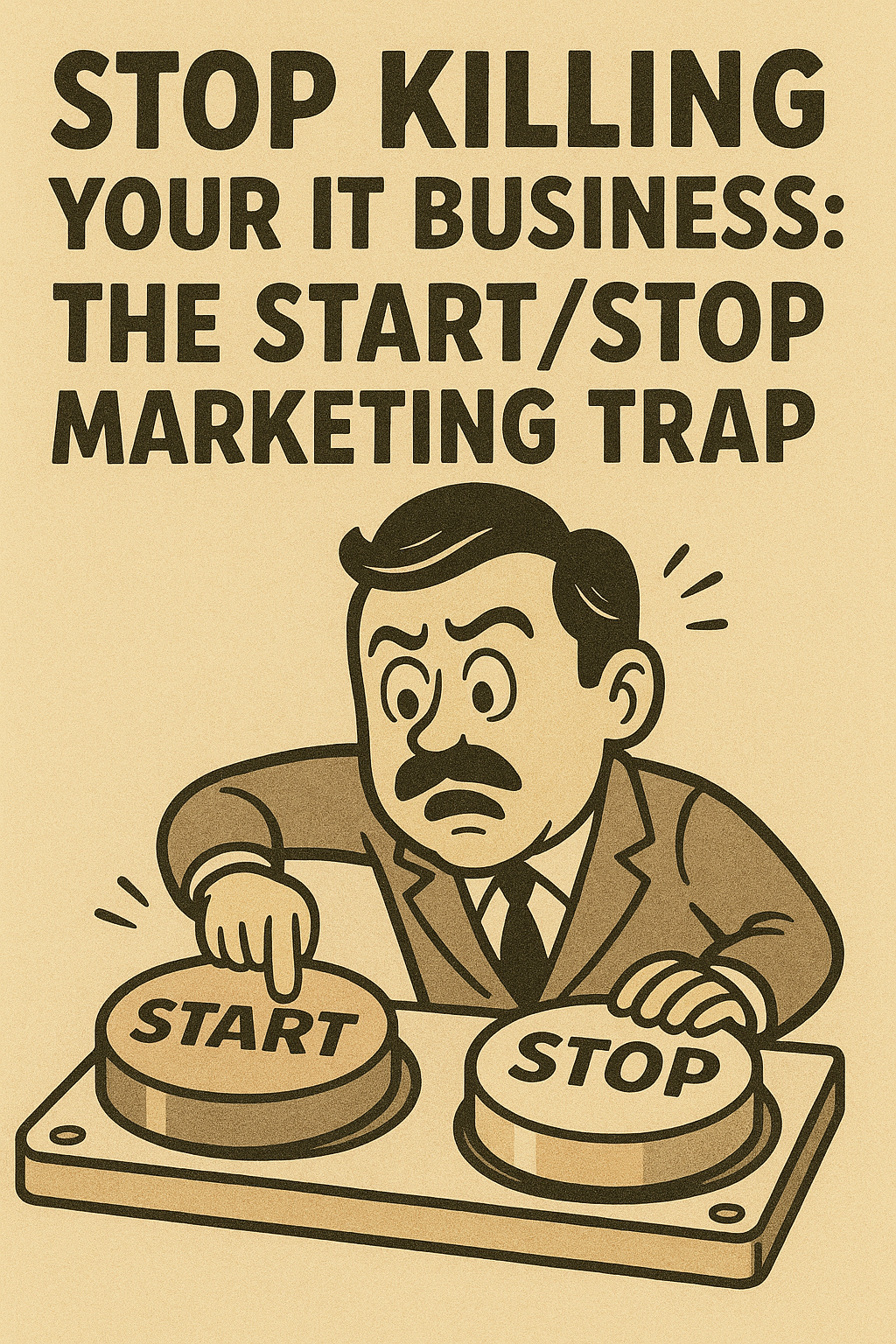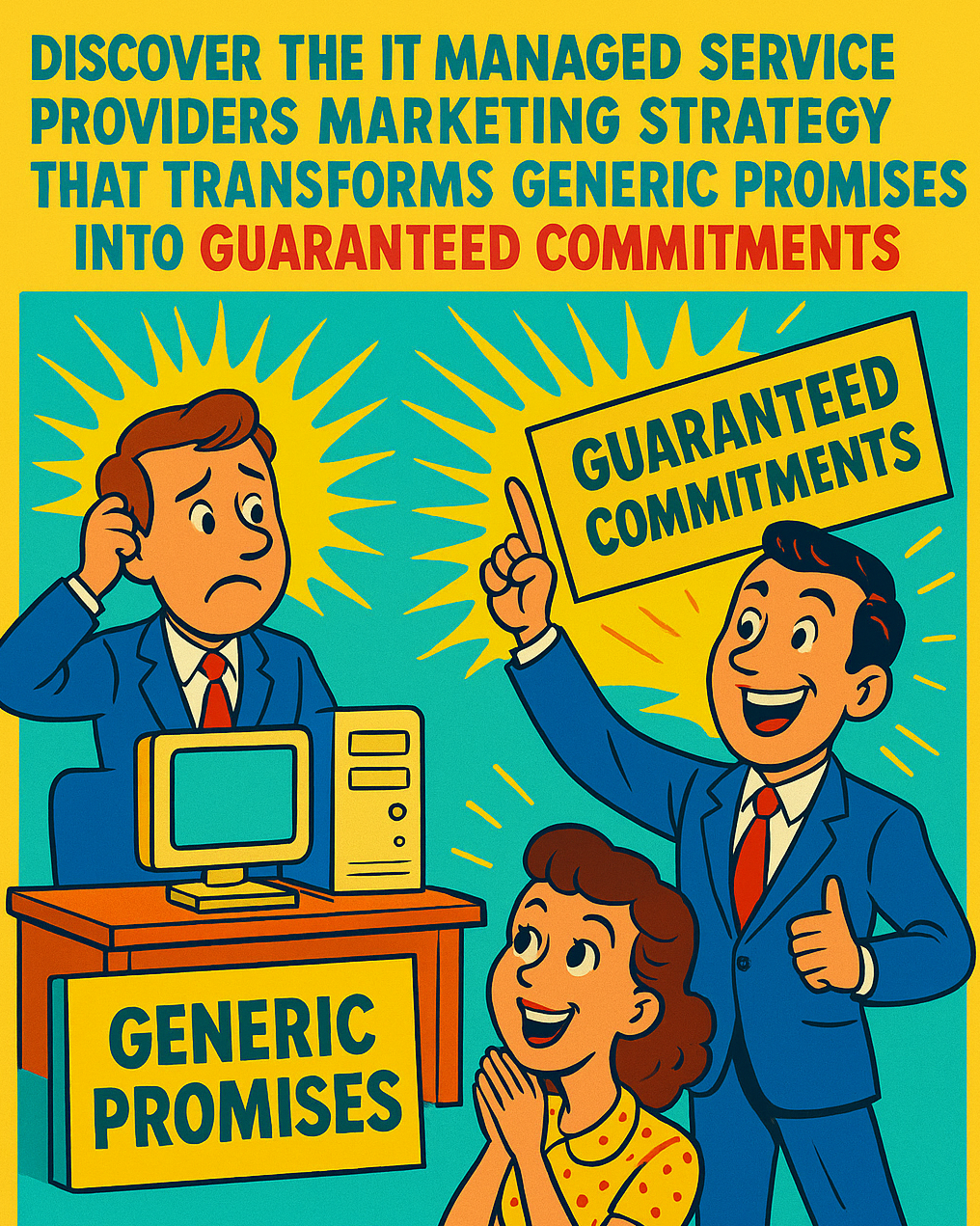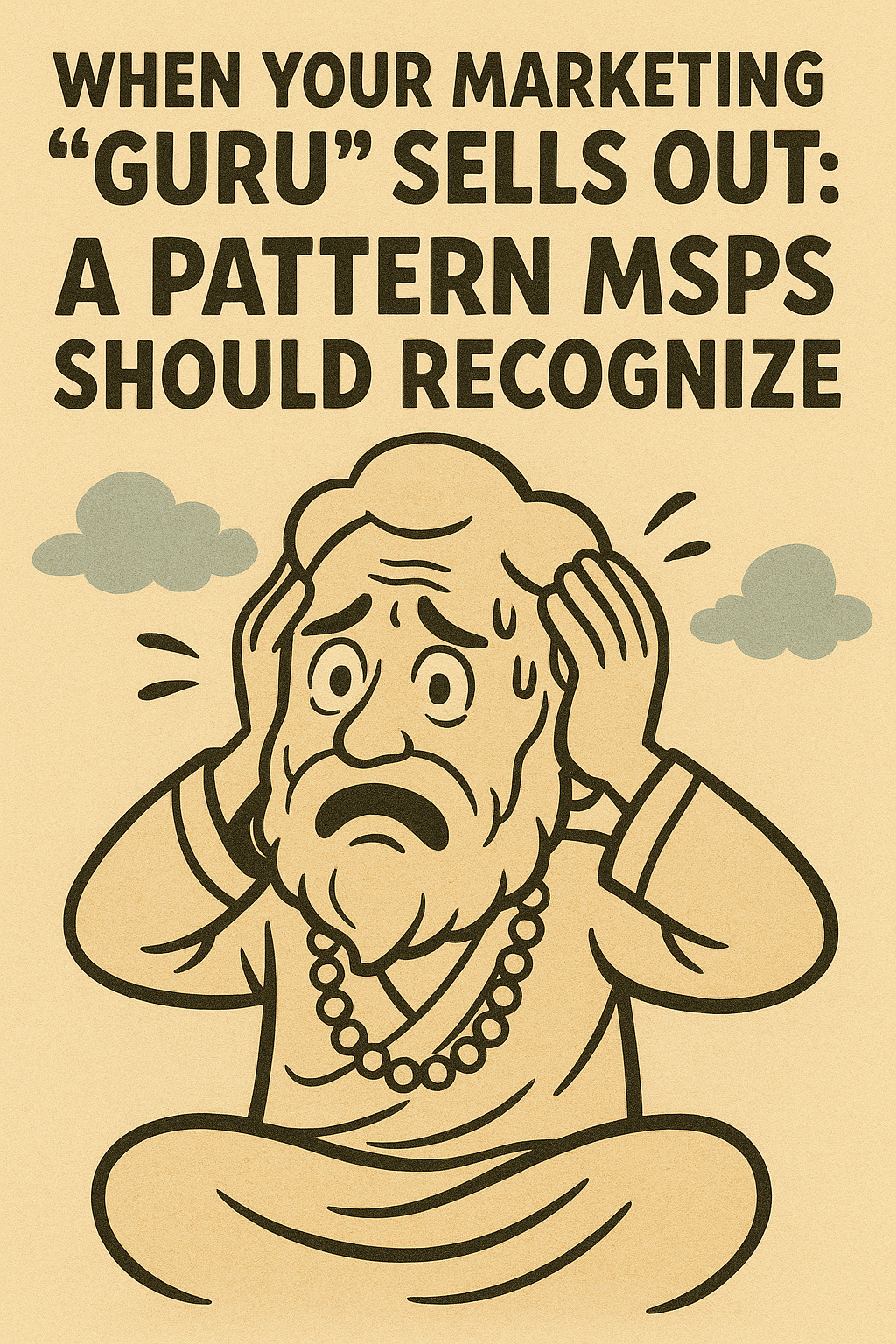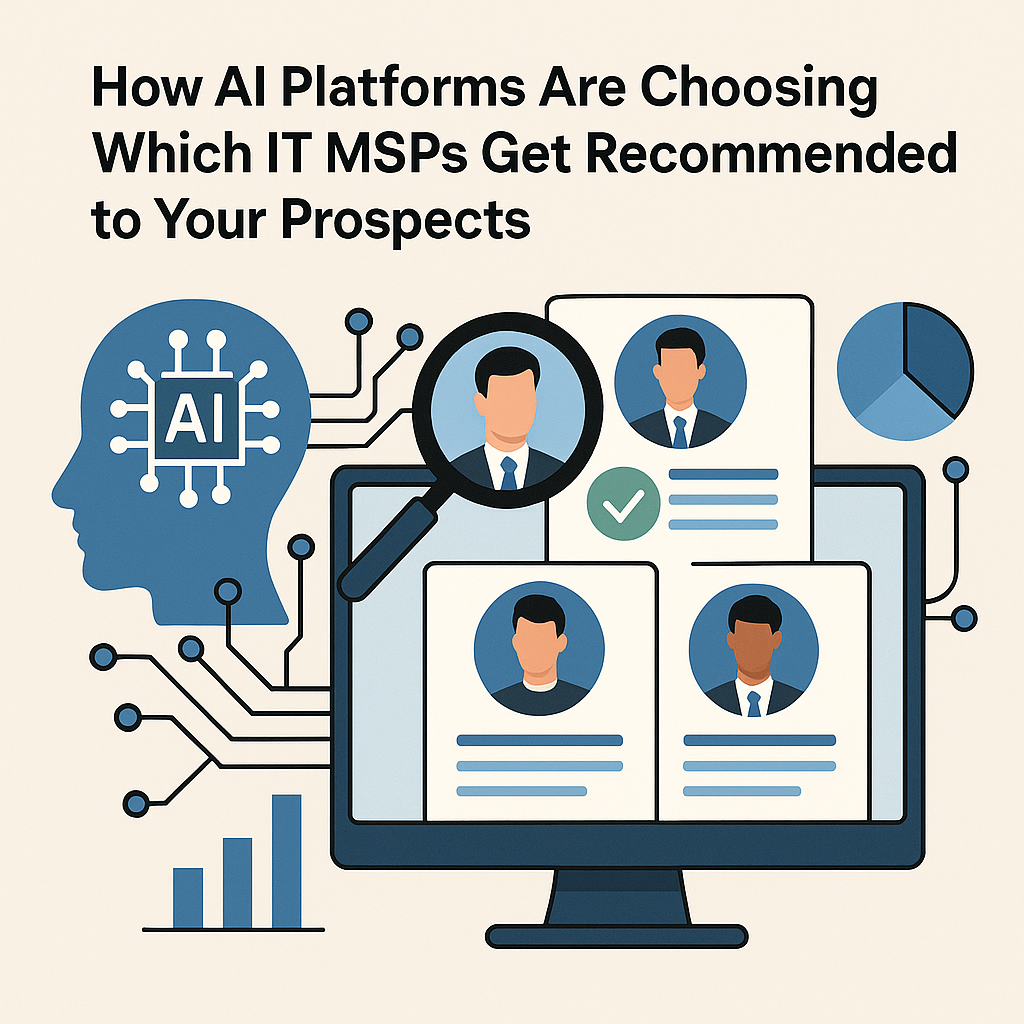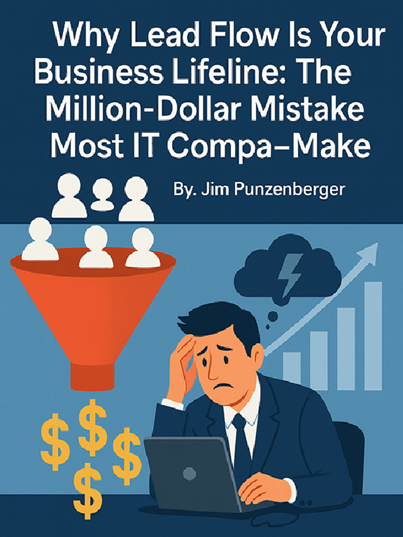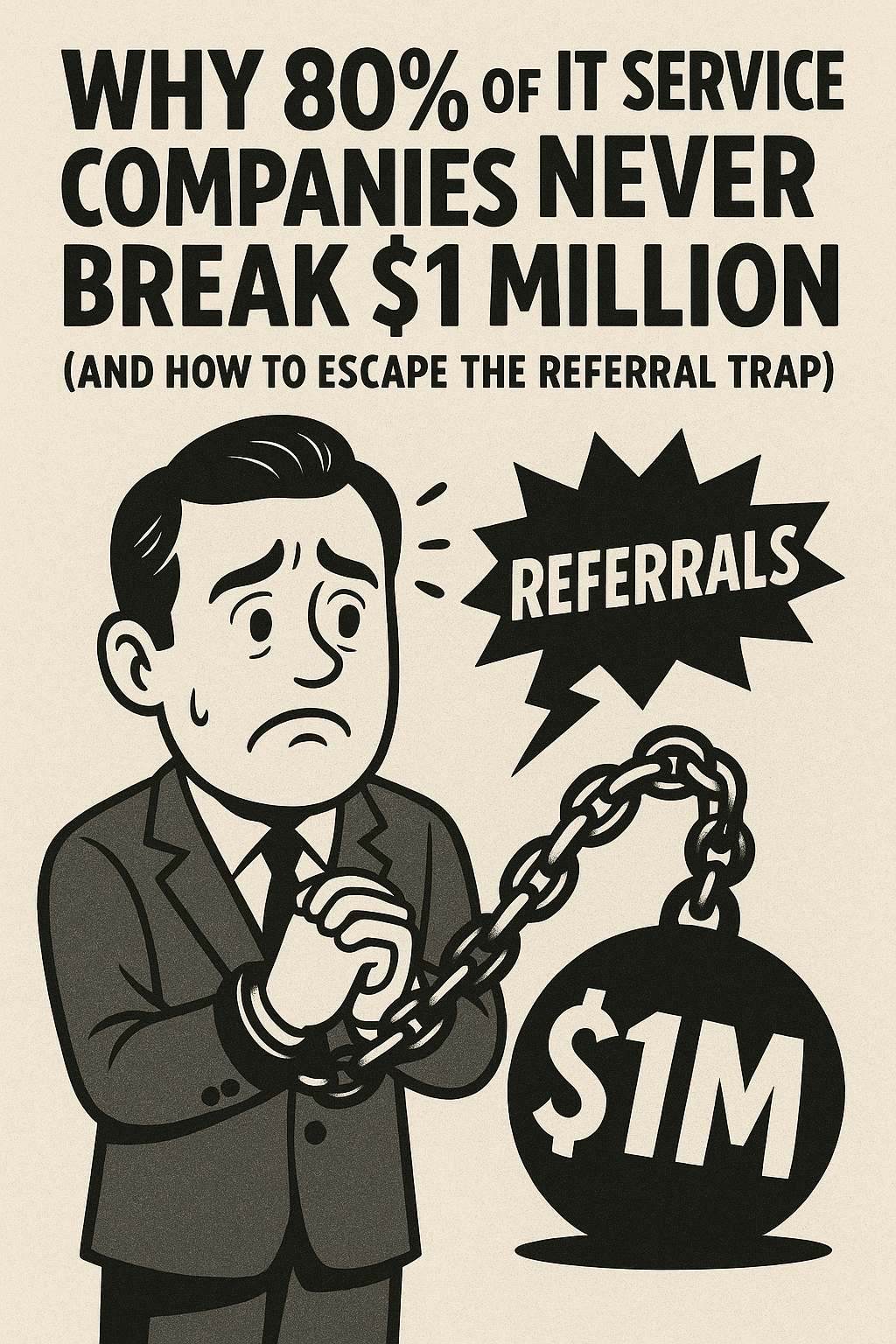
How to Grow Your IT Services Business Beyond Referrals with LinkedIn & Email
Why 80% of IT Service Companies Never Break $1 Million (And How to Escape the Referral Trap)
You’ve been running your IT services company for years. Maybe you’re an MSP, maybe you do break-fix work, perhaps you’re a VAR or manage SaaS implementations. You’ve got 5 to 20 employees, you do good work, and your clients love you.
But here’s the problem: you’re stuck.
You tried that expensive marketing program with the templated postcards. You bought the email blast system. You even hired that marketing person who promised the moon and delivered… well, nothing much. Now you’re back to waiting for referrals and hoping your phone rings.
Sound familiar?
If so, you’re not alone. According to comprehensive industry research from Service Leadership and Robin Robins’ Technology Marketing Toolkit, approximately 80% of IT service providers remain trapped under $1 million in annual revenue. The primary culprit? Lack of systematic marketing approaches that actually work for B2B IT services.
But here’s what the data doesn’t tell you: most IT business owners have tried marketing. They’ve spent money. They’ve followed the “proven systems.” They’ve sent the postcards and emails and newsletters.
So why didn’t it work?
The Brutal Truth About Referral-Only Growth
Let me share something that might hurt a bit: each of your clients has exactly 3 to 7 business contacts they feel comfortable referring to you. That’s it. Once those introductions are exhausted, that referral source essentially stops producing.
This comes from Managed Prospecting System’s analysis of thousands of IT service businesses over the past several years. Think about your own network. How many business owners do you know well enough to refer to a critical service provider? Probably not many.
COVID-19 made this worse by eliminating networking events where organic referrals happened. Now, economic uncertainty makes clients hesitant to make referrals because they fear responsibility if things go wrong. Nobody wants to be the person who recommended the IT company that had a security breach.
While referral-based leads are fantastic (they close at 50% rates versus 20% for marketing leads according to NinjaOne research), they simply cannot scale. You cannot build a million-dollar business on 3 to 7 introductions per client, especially when you’re only adding 5 to 12 new clients per year through referrals.
Why Copy-Paste Marketing Fails IT Service Businesses
Here’s where the IT services industry got it wrong.
For the past 20 years, the dominant marketing approach has been what I call “spray and pray” copy-paste marketing. You know the type: buy the templates, send the same postcards as every other MSP in your market, blast the same email newsletters with the same subject lines, hope something sticks.
The problem isn’t that these approaches never work. Some companies see results. The problem is they work for the first movers and then quickly become saturated.
When every MSP in your city is sending the same “Is Your Network Secure?” postcard and the same “5 Ways Hackers Attack Small Businesses” email, you’re not differentiated. You’re noise. You’re competing on price because you look identical to everyone else.
Robin Robins’ Technology Marketing Toolkit has documented impressive results, with clients achieving 40% revenue growth in the first year and some reaching 147% growth. But here’s what they don’t emphasize: those are the results from their top-performing clients who implemented everything perfectly, often invested $50,000+ in their programs, and got in early.
What about everyone else who bought the system?
According to ConnectWise’s MSP Marketing Report, 85% of IT service providers have one or zero dedicated marketing staff, 58% admit to little or no in-house marketing experience, and 42% spend under $10,000 annually on marketing. These companies bought the templates, sent a few campaigns half-heartedly, saw minimal results, and went back to waiting for referrals.
The copy-paste approach fundamentally misunderstands B2B IT marketing. Small business owners don’t want to buy from the company with the cleverest postcard. They want to buy from someone they know, like, and trust. Someone who understands their specific business challenges. Someone who feels like a real person, not a marketing machine.
The Real Cost of Not Having a System
Let’s talk numbers, because this is where it gets serious.
A typical $500,000 to $900,000 revenue IT services company (the range most businesses with 5 to 20 employees fall into) should be achieving $495,000 in owner compensation once they reach $4.5 million in revenue, according to Channel Futures MSP 501 2024 rankings data. That’s assuming healthy 11% EBITDA margins, which Service Leadership Index research shows is the industry average.
Compare that to CTO salaries ranging from $166,000 to $322,000 according to Glassdoor CTO salary data and ZipRecruiter CTO compensation reports. You went into business to make more than corporate salary, right?
But here’s the problem: without systematic marketing generating predictable pipeline, you’re stuck in the 80% who never break $1 million. Your owner compensation stays below corporate salaries. You’re working harder for less money than you’d make working for someone else.
The opportunity cost is staggering. According to Tortoise & Hare Software analysis, MSPs investing 7.5% of revenue in systematic marketing achieve 20% annual growth with 2:1 ROI within two years. A $750,000 revenue company investing $56,250 annually could reach $1.08 million in year two and $1.3 million in year three.
Without that system? You’re adding maybe $50,000 to $75,000 per year through referrals and client expansion. Over ten years, the wealth accumulation difference totals $2 million to $5 million according to the research synthesis.
That’s not a typo. By not implementing systematic marketing, you’re potentially leaving $2 million to $5 million on the table over the next decade.
What Actually Works: Personalized B2B Outreach
After working with thousands of IT service providers through Managed Prospecting System and hosting hundreds of episodes of the Prophets of IT Podcast, I’ve identified exactly what separates the companies breaking $1 million from those stuck below it.
It’s not templates. It’s not postcards. It’s not buying lists and blasting emails.
It’s personalized, systematic outreach using LinkedIn, email, and content that speaks directly to your ideal client’s specific business challenges.
Here’s what that looks like in practice:
LinkedIn Prospecting Done Right
LinkedIn is the most underutilized tool in IT services marketing. Not LinkedIn ads. Not automated connection request spam. Real, personalized outreach to decision makers at companies that fit your ideal client profile.
This means:
- Identifying companies in your service area with 20 to 100 employees (or whatever your sweet spot is)
- Finding the actual decision makers (not just connecting with everyone)
- Sending personalized connection requests that reference something specific about their business
- Following up with value-first messages that solve problems, not pitch services
- Building real relationships over weeks and months, not days
The data shows LinkedIn outreach, when done properly, generates qualified conversations with IT buyers at a fraction of the cost of traditional marketing. You’re reaching people who already have IT pain points, already have budget authority, and are already in buying mode for companies like yours.
Email Sequences That Don’t Suck
Email marketing generates $36 to $42 per dollar spent according to Pronto Marketing’s 2024 MSP marketing analysis. That’s 3,600% to 4,200% ROI, higher than any other marketing channel.
But here’s the catch: it only works if you’re not sending the same templated garbage everyone else sends.
Effective email sequences for IT services:
- Are triggered by specific behaviors or milestones (not just “it’s Tuesday”)
- Reference the recipient’s industry, challenges, or recent news about their company
- Provide genuine value in every email (insights, assessments, tools)
- Come from a real person with a real signature and real contact info
- Are part of a multi-touch campaign that includes LinkedIn and phone follow-up
When someone receives your email and thinks “wow, this person actually understands my business challenges,” you’ve created differentiation. When they receive the same cyber security checklist that 47 other MSPs sent this month, you’re just noise.
Content That Positions You as the Expert
Here’s where most IT companies get content marketing wrong: they write about what they want to talk about (their services, their technology, their certifications) instead of what their prospects care about (their problems, their risks, their opportunities).
Effective content for B2B IT marketing:
- Addresses specific vertical industry challenges (manufacturing IT issues, healthcare compliance, professional services technology needs)
- Provides actionable frameworks, not just generic advice
- Demonstrates deep expertise without being salesy
- Gets shared on LinkedIn where your prospects hang out
- Supports your email and LinkedIn outreach by giving you something valuable to share
The companies breaking $1 million publish consistently, position themselves as advisors (not vendors), and use content to start conversations rather than close sales.
The Systematic Approach That Replaces Copy-Paste Marketing
Here’s what separates Managed Prospecting System from the copy-paste marketing programs that failed you:
We Don’t Do Templates
Every outreach message is personalized based on the prospect’s industry, company size, technology challenges, and recent business developments. Yes, this takes more work. Yes, it scales differently than blasting 10,000 identical emails. But it actually works because it creates real conversations with real decision makers.
We Focus on Relationships, Not Transactions
The copy-paste approach tries to generate immediate sales from cold prospects. Our approach builds relationships over 6 to 12 week cycles, nurturing prospects from cold to warm to ready-to-buy. This matches how B2B IT services are actually purchased (nobody hires an MSP from a postcard).
We Use the Channels Where IT Buyers Actually Are
LinkedIn is where business owners and IT decision makers spend time. Email is where they communicate about business problems. Content is what they consume when evaluating vendors. We focus on these channels because that’s where your prospects are, not because we have a product to sell you in those channels.
We Make It Systematic Without Making It Robotic
The goal isn’t to eliminate personalization. The goal is to systematize the process of finding prospects, researching them, reaching out personally, following up consistently, and moving them through a relationship-building journey. Think of it like a CRM workflow that prompts human action, not a marketing automation system that removes humans from the process.
According to Kaseya’s 2024 MSP Benchmark Survey of 984 respondents, customer acquisition emerged as the number one challenge for 36% of IT service providers, up dramatically from 24% in 2023. That’s a 50% increase in just one year. The problem is getting worse, not better.
Why? Because the old approaches are saturated. Every IT company is doing the same thing. The companies winning are the ones doing something different.
What It Takes to Break Through $1 Million
According to Service Leadership Index data, average MSP adjusted EBITDA stands at 11.1% worldwide, but the top 10% achieve 25% to 35% net profit margins. That’s the difference between a $1 million revenue company generating $111,000 in owner compensation versus $250,000 to $350,000.
The gap isn’t technology. It’s not talent. It’s not pricing.
It’s systematic customer acquisition that generates predictable pipeline at reasonable cost.
Industry best practices establish that IT service providers should invest approximately 3 months’ worth of Monthly Recurring Revenue to acquire a new client. For a client paying $5,000 monthly, that’s $15,000 to $20,000 customer acquisition cost. At these levels, the economics work favorably: a client paying $5,000 monthly over 14 years generates $840,000 in lifetime revenue.
But MSPs without systematic marketing face substantially higher effective acquisition costs. When your sales rep spends 3 months chasing a prospect who ghosts you, that’s $25,000 in fully loaded sales cost with zero return. When you spend $5,000 on a marketing campaign that generates one lukewarm lead, your cost per acquisition is through the roof.
The Managed Prospecting System approach generates qualified conversations at predictable cost, with clear ROI tracking, and systematic follow-up that doesn’t depend on your sales rep remembering to call people back.
The Real Question: How Long Are You Willing to Stay Stuck?
Here’s what I know after working with hundreds of IT service companies:
The ones who break through $1 million (and then $2 million, $3 million, and beyond) all make one critical decision: they stop waiting for referrals and implement systematic outreach.
They don’t wait for the perfect time. They don’t wait until they have more resources. They don’t wait until marketing gets “easier” or “less expensive.”
They recognize that every month they wait is a month of lost opportunity. According to the research, a $750,000 revenue IT services company without systematic marketing foregoes approximately $750,000 in cumulative opportunity cost over just two years by continuing with referral-only growth.
Think about that. Two years from now, you could have an additional $750,000 in cumulative revenue and profit. Or you could be exactly where you are now, just two years older and two years more frustrated.
The U.S. Bureau of Labor Statistics 2024 business survival data shows a 26.4% first-year failure rate for information technology services companies, the highest of all sectors. Over 10 years, 60.4% of service-based businesses fail. The ones that survive and thrive? They’re the ones who solve customer acquisition before they run out of runway.
Your Next Step
If you’re ready to stop waiting for referrals, stop throwing money at copy-paste marketing programs that don’t work, and start implementing systematic B2B outreach that actually generates pipeline, here’s what I recommend:
Visit managedprospectingsystem.com/how-mps-works to see exactly how we help IT service companies implement personalized LinkedIn and email outreach that builds real relationships with qualified prospects.
You’ll see:
- How we identify and research your ideal prospects
- How we craft personalized outreach that starts conversations
- How we systematically follow up without being pushy
- How we track ROI so you know exactly what’s working
- How we help you break through $1 million (and beyond)
The copy-paste era is over. The companies winning in 2025 and beyond are the ones building real relationships with decision makers through personalized, systematic outreach.
The only question is whether you’ll be one of them.
Frequently Asked Questions
How is Managed Prospecting System different from other MSP marketing programs?
Most MSP marketing programs sell you templates, campaigns, and content that every other MSP is using. We build personalized outreach specific to your ideal prospects, using LinkedIn, email, and content that actually speaks to their business challenges. No two clients send the same messages because no two clients target the exact same prospects in the same way.
How long does it take to see results?
Most IT service companies start seeing qualified conversations within 30 to 45 days and first closed deals within 90 to 120 days. Unlike copy-paste marketing that promises instant results (and rarely delivers), we build relationships over 6 to 12 week cycles that match how B2B IT services are actually purchased.
What if I’ve tried LinkedIn outreach before and it didn’t work?
Most failed LinkedIn outreach attempts use automated tools that spam connection requests and pitch immediately. Our approach builds genuine relationships through personalized research, value-first messaging, and systematic follow-up that doesn’t feel salesy. If you’ve been doing automated spam, you haven’t actually tried LinkedIn prospecting.
How much does systematic marketing cost compared to referrals?
Industry research shows IT service providers should invest 7% to 10% of revenue in marketing. For a $750,000 revenue company, that’s $52,500 to $75,000 annually. This generates 20% growth with 2:1 to 5:1 ROI within two years according to Tortoise & Hare Software analysis. Referrals feel free but they limit you to 5 to 12 new clients per year maximum. Marketing costs money upfront but scales infinitely.
Do you only work with MSPs or all IT service businesses?
We work with MSPs, break-fix companies, VARs, SaaS implementation firms, and any B2B IT service provider with 5 to 20 employees looking to grow beyond referrals. The approach works regardless of your specific IT service model because it’s based on building relationships with decision makers, not selling a particular product.
What size company do I need to be to make this work?
Our sweet spot is IT service companies doing $500,000 to $2 million in revenue who are stuck and ready to implement systematic outreach. Below $500,000, you might not have the resources to fully execute. Above $2 million, you probably need a full marketing team in addition to systematic outreach. But we’ve worked with companies outside this range successfully.
How hands-on is this? Do you do it for me or teach me?
We do the heavy lifting (prospect research, message personalization, campaign management, follow-up tracking) while you focus on having conversations with qualified prospects. Think of us as your outsourced business development team that feeds qualified opportunities to your sales process. You’re not learning a system to implement yourself; you’re getting systematic outreach implemented for you.
What if I’m in a competitive market where lots of IT companies already serve my area?
Personalization is your competitive advantage. When every other IT company is sending the same templated messages, your personalized outreach that references the prospect’s specific business stands out dramatically. We’ve seen this work in highly saturated markets like New York, Los Angeles, Chicago, and other major metros where competition is intense.
Can I really get to $1 million revenue without spending $50,000 on marketing programs?
According to research from Tortoise & Hare Software and industry benchmarks, IT service providers investing 7.5% of revenue in systematic marketing achieve 20% annual growth. For a $750,000 revenue company, that’s $56,250 annual investment reaching $1.08 million in year two. You don’t need to spend $50,000 upfront; you scale investment as you grow. The key is systematic implementation, not massive budget.
What happens if I wait another year to implement systematic marketing?
Every month you wait is a month of lost opportunity. A $750,000 revenue company continuing referral-only growth adds maybe $50,000 to $75,000 per year. With systematic marketing generating 20% growth, you’d add $150,000 in year one. Over two years, the cumulative opportunity cost of waiting reaches approximately $750,000 according to industry analysis. The question isn’t whether to implement systematic marketing; it’s how much you’re willing to lose by delaying.
About the Author:
Jim Punzenberger is the creator of Managed Prospecting System, host of the Prophets of IT Podcast, and author of Zero Dollar Advertising Strategies. He has helped hundreds of IT service companies break through the $1 million revenue barrier through systematic LinkedIn and email prospecting that builds real relationships with qualified B2B prospects.
Sources and Citations:
This article synthesizes data from Service Leadership’s benchmarking platform, Datto’s 2025 State of the MSP Industry report (PDF available at https://www.datto.com/wp-content/uploads/dlm_uploads/DAT-2024-State-of-the-MSP-Report-1.pdf), Kaseya’s 2024 MSP Benchmark Survey (PDF available at https://www.kaseya.com/wp-content/uploads/dlm_uploads/2024/03/Whitepaper-2024-MSP-Benchmark-Survey_Kaseya.pdf), CompTIA IT Industry Outlook 2024 and State of the Channel 2024, ConnectWise MSP Marketing Report, Robin Robins’ Technology Marketing Toolkit, Channel Futures MSP 501 rankings, Pronto Marketing analysis, Tortoise & Hare Software research, and U.S. Bureau of Labor Statistics covering 2022-2025 performance data for North American IT service providers.


